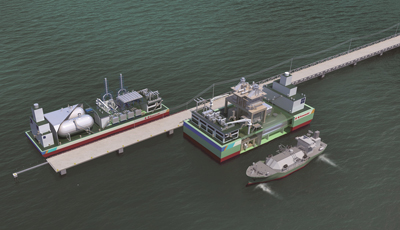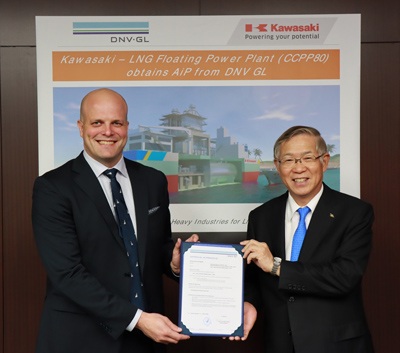Kawasaki's LNG Floating Power Plant (CCPP Model) Obtains AiP from DNV GL
Oct. 16, 2019
 |  | |
| Image of Kawasaki - LNG Floating Power Plant | Shigeru Murayama, Kawasaki (right) and Mr. Stian Erik Sollied, DNV GL (left), at Kawasaki Kobe Works |
Tokyo, October 15, 2019 — Kawasaki Heavy Industries, Ltd. announced today that it has obtained Approval in Principle (AiP)*1 for its liquefied natural gas (LNG) floating power plant equipped with its own gas turbine (combined cycle power plant (CCPP) model). This approval was obtained from world-leading ship classification organization DNV GL*2 based on its latest “Gas Power Plant” rules, which were introduced in 2018.
An LNG floating power plant is an integrated system in which LNG fuel tanks, LNG regasification unit, power generation equipment and switchyard are all outfitted on the hull. It is towed on the sea or river and then moored at the installation site, where it generates power on the hull that is then supplied to the onshore power grid.
Demand for this type of power plant is expected to be strong in countries where demand for electricity is rapidly increasing, such as in Southeast Asia, especially on islands or in locations where it is difficult to secure stable power sources, and also in areas with geographical problems such as lack of land for constructing onshore power plants.
LNG, which is the fuel used for power generation, has a cost advantage over heavy oil and emits less greenhouse gases than coal and heavy oil. As an environmentally friendly fuel, the scale of supply and demand as well as applications of LNG are expected to expand.
With this AiP, following a previous AiP obtained in May of this year for an LNG floating power plant equipped with Kawasaki's own gas engine (gas engine model), Kawasaki's lineup now consists of a CCPP model and a gas engine model, thus enabling the company to better meet a wider range of customer needs.
The main features of the CCPP model are as follows
| (1) | The gas turbine, heat recovery steam generator (HRSG), steam turbine, LNG fuel tank and other main components can be manufactured in Kawasaki's factories, thus enabling reliable service in terms of delivery, product quality, and maintenance and other after-sales services. |
| (2) | It comes equipped with Kawasaki's own gas turbines (simple cycle: 40.3%; combined cycle: 54.4%) featuring the world's highest level in class of power generation efficiency. Each gas turbine uses a self-developed dry low emission (DLE) combustor to achieve the world's lowest level of nitrogen oxide (NOx) emission, 15 ppm or less (at 15% O2), thus reducing the system's environmental load. In addition, borescope inspections and a module exchange method enable greater ease of maintenance, and longer overhaul intervals reduce overall life cycle costs. |
| (3) | A durable, heat-resistant aluminum tank with the same specifications as for small domestic LNG carriers/LNG bunkering vessels is placed inside the hull, with gas turbines installed in its upper portion. Furthermore, vertical HRSGs are installed on the upper side of gas turbines, thus reducing equipment installation footprints and enabling a smaller hull size. |
| (4) | The configuration of multiple shafts (two gas turbines, two HRSGs, and one steam turbine) enables compatibility with a wide range of loads and provides redundancy for main components. |
Since constructing Asia’s first LNG carrier in 1981, Kawasaki has built over 40 LNG-related vessels, designing and manufacturing a wide range of LNG fuel vessels, LNG bunkering vessel and others. The development of this LNG floating power plant achieves the dynamic/static inclination countermeasures, which are indispensable in a floating power plant, and compact layout design by incorporating the LNG carrier and hull design technologies of the Kawasaki Ship & Offshore Structure Company along with the power plant technologies of the Kawasaki Energy System & Plant Engineering Company.
Taking advantage of synergies between these LNG and energy-related technologies, Kawasaki will actively market its energy-related equipment.
| Outline of Specifications of Kawasaki LNG Floating Power Plant | ||||
|---|---|---|---|---|
| Model | CCPP (Combined Cycle Power Plant) |
Gas Engine | ||
| Configuration | Gas turbine combined cycle (2 gas turbines, 2 heat recovery steam generators, and 1 steam turbine) |
Gas engines: 4 units | ||
| Power output | 80 MW | 30 MW | ||
| Barge size | L 110 m × W 48 m × D 20 m | L 120 m × W 36m × D 6.5 m | ||
| LNG tank | 5,500 m3 x 2 units | 3,500 m3 x 2 units | ||
| *1 | Approval in Principle: To obtain confirmation by the classification society as a third party by a risk assessment and verification of compliance with classification rules for the conceptual design of new products and technologies. |
| *2 | DNV GL: Located in Norway, DNV GL is the world’s leading classification society and a recognized advisor for the maritime industry. DNV GL enhances the safety, quality, energy efficiency and environmental performance of the global shipping industry, across all vessel types and offshore structures. The society is also a world-leading service provider offering technical consulting services in the oil and gas fields. |
Contact
If you need more information about our business,
please feel free to contact us.





